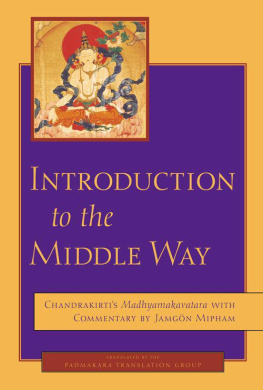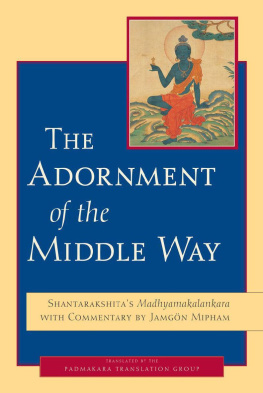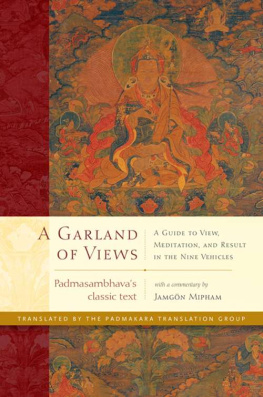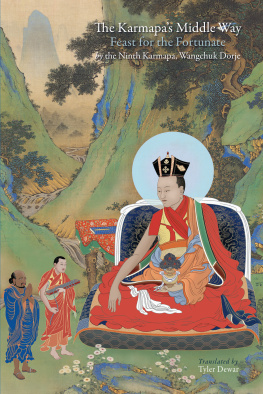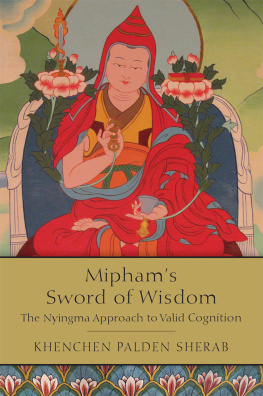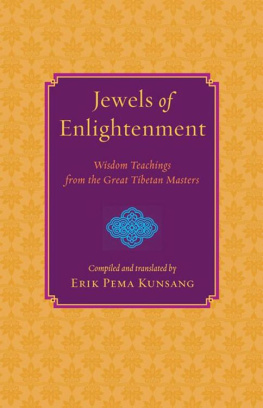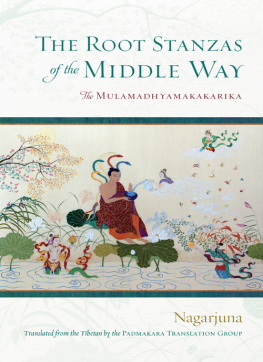ABOUT THE BOOK
Introduction to the Middle Way presents an adventure into the heart of Buddhist wisdom through the Madhyamika , or middle way, teachings, which are designed to take the ordinary intellect to the limit of its powers and then show that there is more.
This book includes a verse translation of the Madhyamakavatara by the renowned seventh-century Indian master Chandrakirti, an extremely influential text of Mahayana Buddhism, followed by an exhaustive logical explanation of its meaning by the modern Tibetan master Jamgn Mipham, composed approximately twelve centuries later. Chandrakirtis work is an introduction to the Madhyamika teachings of Nagarjuna, which are themselves a systematization of the Prajnaparamita , or Perfection of Wisdom literature, the sutras on the crucial but elusive concept of emptiness.
Chandrakirtis work has been accepted throughout Tibetan Buddhism as the highest expression of the Buddhist view on the sutra level. With Jamgn Miphams commentary, it is a definitive presentation of the wisdom of emptiness, a central theme of Buddhist teachings. This book is a core study text for both academic students and practitioners of Mahayana and Vajrayana Buddhism.
JAMGN MIPHAM (18461912), one of the great luminaries of Tibetan Buddhism in modern times, has had a dominant and vitalizing influence on the Nyingma School and beyond. He was an important member of the Rim, or nonsectarian movement, which did much to strengthen and preserve the entire tradition. A scholar of outstanding brilliance and versatility, his translated works are eagerly anticipated by English-language readers.
Sign up to learn more about our books and receive special offers from Shambhala Publications.

Or visit us online to sign up at shambhala.com/eshambhala.

The Padmakara Translation Group gratefully acknowledges the generous support of the Tsadra Foundation in sponsoring the translation and preparation of this book


Shambhala Publications, Inc.
Horticultural Hall
300 Massachusetts Avenue
Boston, Massachusetts 02115
www.shambhala.com
2002 by the Padmakara Translation Group
Cover Art: White Manjushri, used courtesy of the Hahn Cultural Foundation, Seoul.
All rights reserved. No part of this book may be reproduced in any form or by any means, electronic or mechanical, including photocopying, recording, or by any information storage and retrieval system, without permission in writing from the publisher.
The Library of Congress catalogues the previous edition of this book as follows:
Candrakirti.
[Madhyamakavatara. English]
Introduction to the middle way: Candrakirtis Madhyamakavatara; with commentary by Ju Mipham.1st ed.
p. cm.
Includes bibliographical references and index.
eISBN 978-0-8348-2448-5
ISBN 1-59030-009-2 (paper)
ISBN 1-57062-942-0 (cloth)
1. Mdhyamika (Buddhism)Early works to 1800.
I. Mi-pham-rgya-mtsho, Jam-mgon Ju, 18461912.
Dbu ma la jug pai grel pa zla bai zhal lun dri med shel phren English. II. Title.
BQ2910.M3622 E6 2002
294.385dc21
2002017668
Contents

SUPPLEMENTARY DISCUSSIONS APPEARING IN THE TEXT
THIS COMMENTARY on Chandrakirtis Madhyamakavatara was compiled from the notes and oral teachings of Kunkhyen Lama Mipham by Kathok Situ Rinpoche and Khenpo Kunzang Pelden at the request of Shechen Gyaltsap Rinpoche. Mipham Rinpoche was Majushri in person, and his disciples, the scholars who compiled this text, were themselves learned and accomplished masters. We can therefore be confident that the teachings contained in this book are not merely of academic interest; they have been transmitted to us by masters who perfectly understood and actualized their meaning. They are the expression of an authentic tradition that goes back to Chandrakirti and Nagarjuna themselves. It is interesting to recall that Kathok Situ Rinpoche recognized and brought up Jamyang Khyentse Chokyi Lodro, the previous incarnation of Dzongsar Khyentse Rinpoche, while Shechen Gyaltsap Rinpoche was the root teacher of Kyabje Dilgo Khyentse Rinpoche. It is therefore with great pleasure that we in the Padmakara Translation Group are able to present in translation these instructions, which are so closely associated with the lineage of our own teachers.
The Madhyamakavatara itself is a wonderful text, a product of the golden age of Buddhism in India, when the writings of learned masters were composed and assessed according to strict rules. In order to be acknowledged and proclaimed, these writings had to pass the stringent test of other qualified masters, who were appointed by the king, so that when they were finally published, their authority and reliability were guaranteed. Their ensuing celebrity was therefore well founded and was not merely the outcome of publicity and popular opinion. Why is this so important? It is important because, once we are sure that a writer is trustworthy, we know that we are in touch with the authentic tradition. Through Mipham Rinpoche we have access to Chandrakirti and through him to Nagarjuna. Through Nagarjuna, we may enter the Prajaparamita and thus the very essence of the Buddhas teaching.
Of course, Madhyamika is challenging. It is not something that we can hope to understand in a single reading. It requires discipline, concentration, and repeated effort. It is good to remember that Chandrakirti and Shantideva did not become great panditas overnight. They and all the great scholars of the lineage studied the teachings with courage and perseverance. And if at times the study of Madhyamika seems arduous and difficult, we should remind ourselves that the fruit that we may reap from our endeavor is extremely worthwhile and will serve us wellfar better perhaps than the relaxed and casual daydreaming that is so often a feature of our meditation!
We in Padmakara have attempted to translate these texts in accordance with the wishes and instructions of Dzongsar Khyentse Rinpoche, who, with immense kindness and in order to continue the tradition of teaching established here by Kyabje Dilgo Khyentse Rinpoche, made visits to Dordogne over several years and gave a complete instruction on the Madhyamakavatara. In offering this translation to him, we would like to express our deep gratitude as well as our prayers for his long life and the continuous increase of his enlightened activities.
Jigme Khyentse
Dordogne, 2001
THIS BOOK is the result of a translation project that grew out of a series of teachings on Chandrakirtis Madhyamakavatara given by Dzongsar Khyentse Rinpoche in Dordogne, France, in the course of four summer seminars in 1996 and from 1998 to 2000. Although the exposition was based on a commentary composed by the fifteenth-century Sakya master Gorampa Sonam Senge, when a translation of the root verses was called for, it was specified that it should be made according to the commentary of the nineteenth-century Nyingma master Jamgn Ju Mipham. Since the translation of Chandrakirti required constant reference to an authoritative source, we decided to make a complete translation of Mipham Rinpoches commentary as well and to offer it here as a key to understanding the general meaning of the root text.
Next page
